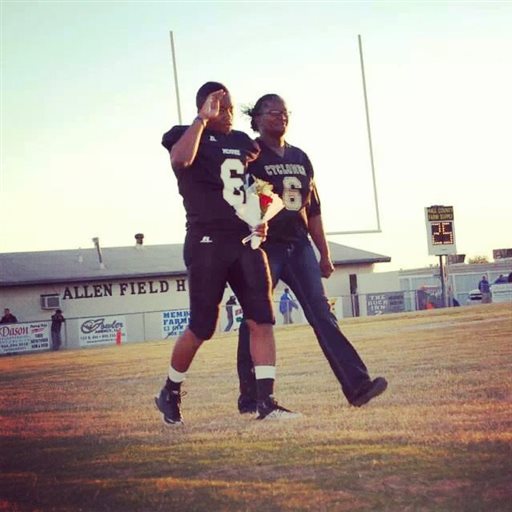(AP) West Texas teen who survived 2 strokes scores TD
By BETSY BLANEY
Associated Press
LUBBOCK, Texas
Just three months after Kenbriel Hearn emerged from a coma, the 18-year-old football star scored the most memorable touchdown of his life.
The senior at Memphis High School suffered two strokes caused by a bleeding mass on his brain and spent three weeks on life support. By the time he awoke this past summer, 5-foot-7 frame had withered from 160 pounds to 112. He was paralyzed on his right side, unable to walk or talk.
His football season was the last thing on his mind.
Once regaining the ability to jog, Hearn found himself back in pads when his coach asked him to suit up for the Cyclones’ final home game. He figured he was on the sideline for moral support, but unbeknownst to him, both coaches had arranged for a special moment to highlight his road to recovery.
With Memphis trailing 35-0 in the final minute, Hearn was sent into the huddle and given directions to take the handoff and go.
He jogged 48 yards to the end zone, where players from both teams cheered him. He briefly knelt to pray as his mother, Tammy Henderson, looked on, tears streaming down her face.
It wasn’t the first touchdown Hearn scored in his three seasons as a Memphis receiver and safety, but it was his sweetest.
“I will remember this one more because I battled through so much,” said Hearn, who continues speech and physical therapy. “It was pretty great.”
Cyclones coach Andy Correll hatched his plan the week before the Nov. 1 game in Memphis, about 85 miles southeast of Amarillo in the Texas Panhandle. He emailed his counterpart at Stratford about his plan to let Hearn have one play. Stratford coach Eddie Metcalf went for it.
But with the Stratford Elks working on a shutout, Correll thought Metcalf might not want to spoil the accomplishment for his defense.
During a meeting at midfield, Correll suggested just allowing Hearn to pick up a first down. But Metcalf insisted he take it all the way to the end zone.
“Just let the boy go,” he told Correll.
Metcalf later explained it was an “easy response,” just as good as being part of three state titles.
“The shutout didn’t mean anything in comparison to what that kid would do to me and to our kids,” Metcalf said.
When Hearn got the news, his first thought was his mother would be angry. “My second thought was he can’t be serious,” he said.
Hearn’s mother had been clued in earlier in the day that her son would get into the game. She kept mum but acknowledged it was difficult not to tell anyone.
“When he got the ball and started running tears just started streaming down my face,” said Henderson, 43. “Him taking the field that last day, it was just joyful.”
Correll and his players, who started each practice this fall with a prayer for Hearn, were ecstatic after Hearn’s TD.
“All our kids were giving him hugs,” Correll said. “He was bawling and I was, too. He just said, `Thank you,’ and that he loved me, and of course I said the same thing back.”
Just a few months earlier, Henderson faced the real prospect of losing her son. Doctors told her the mass on her son’s brain was a congenital cavernoma _ a collection of small blood vessels in the central nervous system that is enlarged and irregular in structure. They are believed to occur in the general population once in 1,000 people.
Hearn’s cavernoma was at the base of his skull on his brain stem. Bleeding from it caused Hearn’s first stroke. Three days after surgery to remove the mass, he had another stroke, this one affecting his breathing and swallowing. CPR brought him back to life and being on life support allowed the healing to continue.
After recovering Hearn went to San Antonio for rehabilitation.
The seriousness of a cavernoma depends on its location, said Dr. Ben Baronia, who was not involved in Hearn’s treatment and is an assistant professor of surgery at Texas Tech University Health Sciences Center School of Medicine in Lubbock.
Cavernomas can be fatal, especially when they are near areas of the brain that control breathing, as was the case with Hearn, he said.
“I think that’s a remarkable recovery,” Baronia said of Hearn being able to jog for the arranged touchdown.
Before he graduates to pursue a career as a juvenile probation officer, Hearn aims to accomplish more in high school athletics this spring by joining the track team.
He has regained all of his weight _ and more _ can walk and talk again but will have to get a follow-up MRI in a few months. If all is well, doctors will use other than bone to replace the flap removed from his skull during surgery.
He’ll also continue rehab to meet his goal of running on the track team in the spring. He’s now able to run a lap around the track, do a few sprints and lift some weights.
Hearn said his faith helped him survive, and the lessons he learned will remain for the rest of his life.
“It showed a lot of people don’t let anything stop you,” Hearn said. “Just put God first. No excuses.”

COMMENTS
Please let us know if you're having issues with commenting.